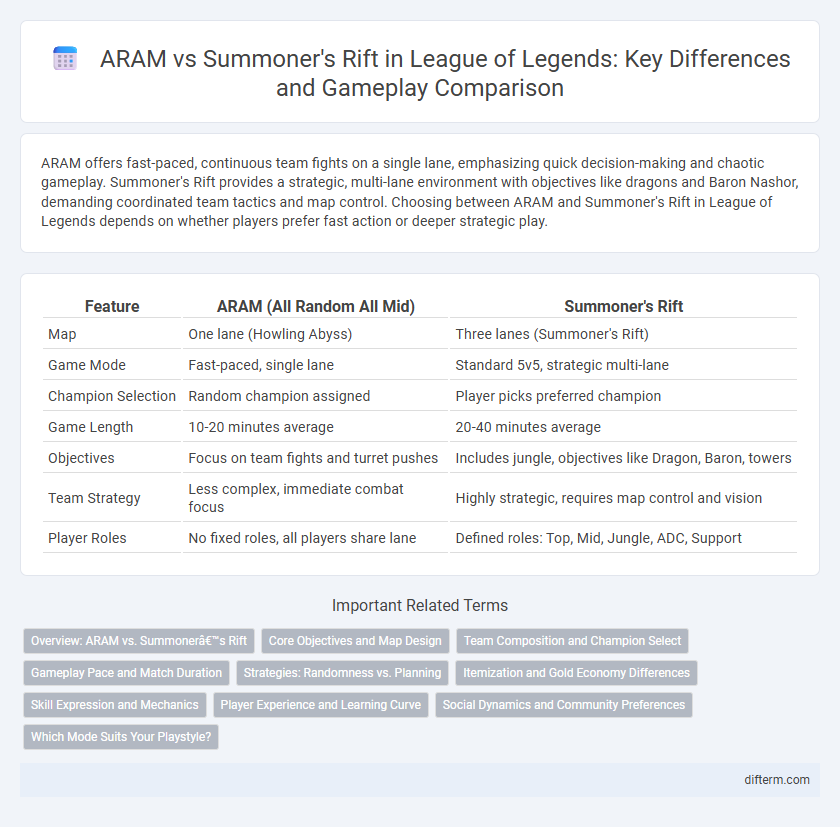ARAM offers fast-paced, continuous team fights on a single lane, emphasizing quick decision-making and chaotic gameplay. Summoner's Rift provides a strategic, multi-lane environment with objectives like dragons and Baron Nashor, demanding coordinated team tactics and map control. Choosing between ARAM and Summoner's Rift in League of Legends depends on whether players prefer fast action or deeper strategic play.
Table of Comparison
| Feature | ARAM (All Random All Mid) | Summoner's Rift |
|---|---|---|
| Map | One lane (Howling Abyss) | Three lanes (Summoner's Rift) |
| Game Mode | Fast-paced, single lane | Standard 5v5, strategic multi-lane |
| Champion Selection | Random champion assigned | Player picks preferred champion |
| Game Length | 10-20 minutes average | 20-40 minutes average |
| Objectives | Focus on team fights and turret pushes | Includes jungle, objectives like Dragon, Baron, towers |
| Team Strategy | Less complex, immediate combat focus | Highly strategic, requires map control and vision |
| Player Roles | No fixed roles, all players share lane | Defined roles: Top, Mid, Jungle, ADC, Support |
Overview: ARAM vs. Summoner’s Rift
ARAM in League of Legends offers a fast-paced, single-lane experience on the Howling Abyss, emphasizing continuous team fights with random champion selection, contrasting with Summoner's Rift's three-lane map that demands strategic objectives, jungle control, and diverse playstyles. Summoner's Rift features complex macro gameplay involving objectives like Dragon, Baron Nashor, and turret control, while ARAM prioritizes immediate skirmishes and constant action without resets or recalls to base. ARAM's shorter matches appeal to casual play and quick sessions, whereas Summoner's Rift provides a deeper competitive experience with prolonged strategic planning and role specialization.
Core Objectives and Map Design
ARAM features a single-lane map called Howling Abyss, emphasizing constant team fights and quick skirmishes with one core objective, the enemy Nexus. Summoner's Rift offers a more complex three-lane map designed for strategic play, with multiple objectives like Dragon, Baron Nashor, and turrets that influence map control and resource management. This design difference shapes ARAM as fast-paced and combat-focused, whereas Summoner's Rift requires layered tactics and objective prioritization.
Team Composition and Champion Select
ARAM mode in League of Legends features a randomized champion select from a single lane map, emphasizing adaptability and team synergy despite limited champion choice. In contrast, Summoner's Rift allows strategic champion picks and bans across three lanes, promoting specialized roles and complex team compositions tailored to counter opponents. Effective team composition in Summoner's Rift involves balancing crowd control, damage types, and crowd sustain, while ARAM prioritizes champions with strong poke and sustain to thrive in constant team fights.
Gameplay Pace and Match Duration
ARAM offers a faster gameplay pace with constant team fights on a single lane, resulting in shorter match durations averaging around 15-20 minutes. Summoner's Rift features a more strategic, multi-lane map with objective control moments, extending match times to 30-45 minutes on average. The quicker ARAM matches appeal to players seeking rapid, action-packed experiences, while Summoner's Rift provides a deeper tactical challenge over longer game sessions.
Strategies: Randomness vs. Planning
ARAM emphasizes adaptability and quick decision-making due to its single-lane map and random champion selection, requiring players to leverage unpredictable team compositions effectively. In contrast, Summoner's Rift demands meticulous planning, with strategic objectives like dragon control, vision placement, and lane assignments playing crucial roles in securing victory. Effective ARAM gameplay thrives on spontaneous synergy, while Summoner's Rift success hinges on coordinated tactics and map control mastery.
Itemization and Gold Economy Differences
ARAM in League of Legends offers streamlined itemization due to restricted shop access and random champion selection, emphasizing early-game power spikes and sustain items. Summoner's Rift supports complex gold economy strategies with lane control influencing farm, item timing, and power spikes, encouraging diverse build paths. Itemization in ARAM favors cost-effective sustain and survivability, while Summoner's Rift promotes adaptive builds driven by precise gold income and role-specific needs.
Skill Expression and Mechanics
ARAM (All Random All Mid) in League of Legends offers fast-paced gameplay with limited map complexity, emphasizing continuous team fights that highlight mechanical skill in positioning and cooldown management. Summoner's Rift provides a deeper strategic layer where players demonstrate advanced skill expression through diverse map control, objective prioritization, and intricate champion mechanics like wave management and vision control. The broader tactical depth in Summoner's Rift requires higher mechanical versatility and decision-making compared to the focused, high-tempo, and mechanically intense skirmishes typical in ARAM.
Player Experience and Learning Curve
ARAM offers a fast-paced, team-focused experience with a simplified, single-lane map that encourages constant skirmishes, making it accessible for players seeking quick matches and casual gameplay. Summoner's Rift provides a more complex environment with three lanes, jungle objectives, and strategic depth, fostering a steeper learning curve that enhances map awareness, champion synergy, and long-term skill development. Players often use ARAM to practice champions and mechanics in a low-pressure setting, while Summoner's Rift challenges them to master macro strategies and adapt to diverse team compositions.
Social Dynamics and Community Preferences
ARAM fosters a fast-paced, team-oriented social dynamic that encourages casual cooperation and quick strategic decisions, appealing to players who enjoy spontaneous and less competitive matches. Summoner's Rift, with its complex gameplay and longer match duration, attracts a community focused on in-depth strategy, teamwork coordination, and competitive play, fostering stronger bonds and higher communication within established groups. Community preferences often split between ARAM's accessibility for social play and Summoner's Rift's depth for competitive engagement, reflecting distinct player motivations and interaction styles.
Which Mode Suits Your Playstyle?
ARAM offers fast-paced, teamfight-heavy gameplay ideal for players who enjoy constant action and quick matches, emphasizing random champion selection for strategic adaptation. Summoner's Rift suits those who prefer a more strategic, objective-driven experience with distinct lanes, jungling, and paced team coordination. Choosing between ARAM and Summoner's Rift depends on whether you favor rapid combat and casual play or in-depth strategy and longer, more tactical games.
ARAM vs Summoner’s Rift (LoL) Infographic

 difterm.com
difterm.com